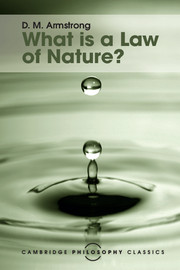Book contents
- Frontmatter
- Dedication
- Contents
- Preface to this edition
- Acknowledgements
- Part I A critique of the Regularity theory
- 1 Introductory
- 2 Critique of the Regularity theory (1): The problem of accidental uniformities
- 3 Critique of the Regularity theory (2)
- 4 Critique of the Regularity theory (3)
- 5 Can the Regularity theory be sophisticated?
- Part II Laws of nature as relations between universals
- Conclusions
- Works cited
- Index
1 - Introductory
from Part I - A critique of the Regularity theory
Published online by Cambridge University Press: 05 July 2016
- Frontmatter
- Dedication
- Contents
- Preface to this edition
- Acknowledgements
- Part I A critique of the Regularity theory
- 1 Introductory
- 2 Critique of the Regularity theory (1): The problem of accidental uniformities
- 3 Critique of the Regularity theory (2)
- 4 Critique of the Regularity theory (3)
- 5 Can the Regularity theory be sophisticated?
- Part II Laws of nature as relations between universals
- Conclusions
- Works cited
- Index
Summary
The importance of our topic
The question ‘What is a law of nature?’ is a central question for the philosophy of science. But its importance goes beyond this relatively restricted context to embrace general epistemology and metaphysics. In this section I will first discuss the importance of the question for the philosophy of science and then its importance in the wider context.
Natural science traditionally concerns itself with at least three tasks. The first is to discover the geography and history of the universe, taking ‘geography’ to cover all space and ‘history’ to cover all time, including future time. Astronomy is beginning to give us a picture of how the universe as a whole is laid out in space and time. Some other natural sciences give us an overview of more restricted spatio-temporal areas.
A second task is to discover what sorts of thing and what sorts of property there are in the universe and how they are constituted, with particular emphasis upon the sorts of thing and the sorts of property in terms of which other things are explained. (These explainers may or may not be ultimate explainers.)
The third task is to state the laws which the things in space and time obey. Or, putting it in the terms used in describing the second task, the third task is to state the laws which link sort of thing with sort of thing, and property with property.
It may not be obvious that there is a second task to be distinguished from the third. But consider the scientific discovery that heat is molecular motion. It is obvious that this is not a historical/geographical truth. I shall argue at a later point that it is not a law of nature, even a ‘bridge law’ (Ch. 10, Sec. 1). It is something different: it gives the constitution of a property, or range of properties, in terms of more ultimate properties. (It could be said to give the ‘geography’ of a property.)
What is true is that the three enquiries are inextricably bound up with each other. They logically presuppose each other and can only be pursued in conjunction with each other. Nevertheless, they are distinguishable.
- Type
- Chapter
- Information
- What is a Law of Nature? , pp. 3 - 9Publisher: Cambridge University PressPrint publication year: 2016
- 2
- Cited by



